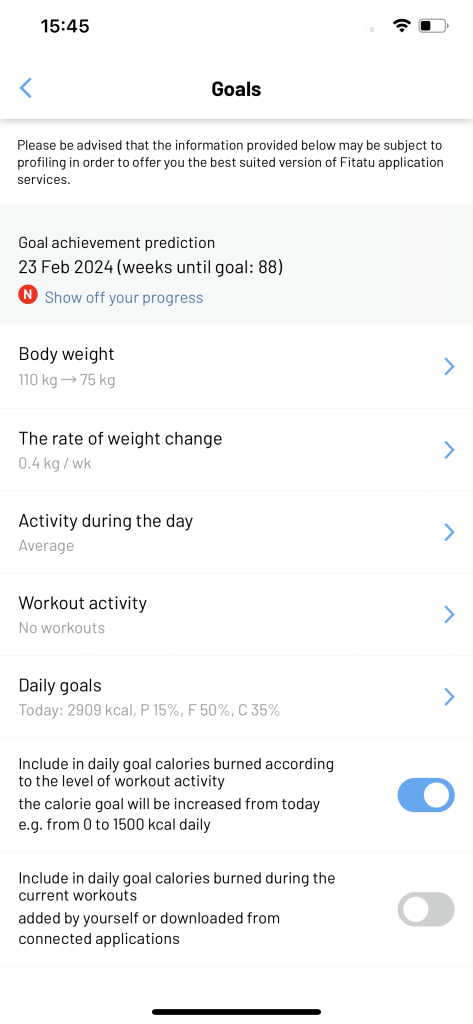How to calculate your caloric needs correctly?

Practically every person who wants to start their adventure with weight loss or muscle mass building has heard at least once about the need to know their calorie requirements. At first, however, it sounds rather enigmatic. What exactly is the calorie requirement? And how to calculate it? Is it worth trusting the demand calculators when each of them gives a slightly different result? You will find out in the article below.
Definition of caloric demand
Caloric/energy demand is the amount of energy which needs to be supplied to the body with food each day in order to cover its energy expenditure. This expenditure is influenced by physiological processes (e.g. respiration, digestion, circulation) called basal metabolism and physical activity. This demand is determined in kilocalories (kcal) or kilojoules (kJ). Knowledge of the energy requirement is essential for skilful diet planning.
How do I calculate my calorie needs?
Calculation of how many calories we should provide each day always starts with calculating the so-called TMR or total metabolic rate. It consists of BMR (basal metabolism rate) and PAL (psychical avtivity level). The formula is as follows:
TMR = BMR x PAL
In order to calculate your final caloric needs, you also need to know what your goals are. In order to lose weight, a calorie deficit is taken into account (usually between 500-1000 kcal per day, which corresponds to a desire to lose 0.5-1 kg per week). If you want to increase body weight, a calorie surplus is taken into account.
The most difficult in these calculations is to choose the right formula for BMR and the right coefficient of PAL.
What is basal metabolism
Basal metabolism is the smallest rate of metabolism that occurs in the human body and which is also necessary to sustain basic life functions. It is calculated for an organism in a waking state, under conditions of complete mental and physical calmness and adequate thermal comfort. It can consume from 45-70% of the total daily energy requirement.
Basal metabolism depends on various factors, including sex, age, height, weight, health, physiological state (e.g. pregnancy), etc.
How to calculate basal metabolism
There are many formulas for calculating BMR (basal metabolism rate). Among the most popular are:
- FAO/WHO
- Harris-Benedict
- Mifflin
FAO/WHO
The FAO/WHO formula is based on age, gender and body weight. We use this formula in our Fitatu calorie calculator as it is an internationally recognised formula.
| Age | Male | Female |
| 11 – 18 years old | 17,686 * weight + 658,2 | 13,384 * weight + 692,6 |
| 19 – 30 years old | 15,057 * weight + 692,2 | 14,818 * weight + 486,6 |
| 31 – 60 years old | 11,472 * weight + 873,1 | 8,126 * weight + 845,6 |
| over 60 years old | 11,711 * weight + 587,7 | 9,082 * weight + 658,5 |
Harris-Benedict
The Harris-Benedict formula is based on age, sex, weight and height.
| Male | Female |
| 66,47 + 13,7M + 5,0W – 6,76L | 655,1 + (9,567M) + (1,85W) – (4,68L) |
M – body mass in kilograms
W – height in centimetres
L – age in years
Mifflin
The Mifflin formula is based on age, sex, weight and height.
| Male | Female |
| (10 x body weight in kg) + (6.25 x height in cm) – (5 x age in years) + 5 | (10 x body weight in kg) + (6.25 x height in cm) – (5 x age in years) – 161 |
Comparison
The calculations for a man aged 30, weighing 85 kg and 190 cm tall would be as follows in each of these formulas:
| Formula | Counted BMR |
| FAO/WHO | 1972 kcal |
| Harrisa-Benedicta | 1978 kcal |
| Mifflina | 1892 kcal |
All these formulae are correct. They all provide reliable data. Nevertheless, the calculated values for the same person may differ slightly. However, these differences are not significant, because always the obtained data is only an estimate. It is impossible to calculate the exact BMR with 100% certainty, and the differences in the formulas are not large enough to affect the goals we set ourselves.
What is Physical Activity Factor and how do I determine it?
Physical Activity Level (PAL) is an indicator that determines the intensity of daily activity and is used to calculate daily energy requirements. PAL includes, among others, our training and non-training activity. When choosing it, the average activity of the week should be taken into account.
Expert consultation with the FAO/WHO/UNU in 1985 led to the following PAL ranges
| PAL | Category | Description | Example |
| 1.40-1.69 | Sedentary or light lifestyle | Low-effort occupations, no long-distance walking, use of motor vehicles for transport, no regular exercise, most leisure time spent sitting or standing | Office workers in urban areas who rarely engage in demanding physical activities during or outside working hours |
| 1.70-1.99 | Active or moderately active lifestyle | People with occupations that are not very strenuous in terms of energy requirements but involve higher energy expenditure than those described in a sedentary lifestyle, or people with sedentary occupations but who regularly train | Bricklayers, farmers and other professions requiring higher physical activity while not regularly practising sport or office workers who regularly practise sport (e.g. 1h cycling/jogging at least 4 times a week) |
| 2.00-2.40 | Energetic or vigorously active lifestyle | People who perform very strenuous work or strenuous leisure activities for several hours a day | People who have sedentary jobs but exercise intensively for an average of 2 hours a day (e.g. swimming or dancing) or non-mechanised agricultural workers who work with axes, hoes, etc. for several hours a day and cover long distances over rough terrain and with heavy loads |
As it can be seen PAL usually takes the value between 1.4 and 2.4. Sometimes it can take lower values, but only in the case of people lying down and then its value is 1.2. On the other hand PAL higher than 2.2 is directed only to professional athletes who perform daily very hard training and then PAL value can be estimated even at 2.4. PAL values above 2.4 are not proposed because they are difficult to maintain in the long term.
It should also be added that the division developed by FAO/WHO/UNU is very general. Usually a specific PAL value fitting into the given ranges is proposed e.g. PAL 1.5, PAL 1.7 etc. Correct description of individual values is very difficult.
Differences in calculation of requirements in various calculators
Demand calculators available on the Internet calculate BMR, TMR and calorie intake based on the target number of calories that you have set yourself.
Each calculator may, however, use different basic metabolism formulas or describe activity levels in a different way which may result in different values for a given person.
With differences resulting from different calculations of BMR by using different formulas, you do not need to worry, because these differences, as we have already mentioned, are not important when reaching your goals. The problem, however, is the difficulty of choosing the right physical activity factor. Many calculators are based on very vague descriptions or focus too much only on training activity, not taking into account non-training activities resulting from your profession or lifestyle.
For this reason, in our Fitat calorie calculator we have broken down the determination of PAL values into workout and non-workout activity.

Thanks to this, the app determines the PAL value much more accurately and, consequently, calculates caloric requirements much better.
Fitatu App
Download the application from the Play Store or Apple Store and start counting your macros with us!
Do you prefer the web version? No problem. A basic web version is prepared for our subscribers. And now you can use the KCAL-C discount code by going to https://www.fitatu.com/app/giftcode and get 29% off your monthly Fitatu Premium.
What else can you find in Fitatu Premium?
- over 1000 recipes plus several new ones every month
- additional plans for intermittent fasting
- the ability to create shopping lists
- a choice of six ready-made menus full of meals to choose
- filtering products and recipes
- more synchronization with fit apps
- access to the application in the web version
- no ads!







